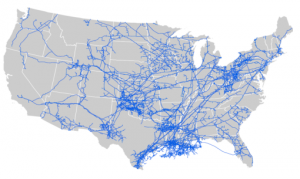From an Article by Tina Casey, Triple Pundit, February 24, 2022
Environmental activists and local stakeholders have racked up a series of legal victories against new gas pipelines in recent months, prompting the Federal Energy Regulatory Commission (FERC) to take a close look at the big picture. If new pipeline approvals are failing in court, then FERC’s standards are either too low, out of date or both. The standards need to be updated, and that is exactly what FERC has done, in a set of two new policy statements announced last week.
In past years, FERC has denied permission for new gas projects on grounds of need. Failure to prove demand, for example, was a leading factor in FERC’s decision to hit the brakes on the proposed Jordan Cove gas export terminal in Oregon, in 2016.
However, many other projects have slipped under that bar, and pipeline opponents have been making the case for a more holistic – and realistic — approach that factors in climate impacts, social justice issues and other elements.
It’s no coincidence that many of the recent courtroom failures have occurred in Virginia and the surrounding mid-Atlantic region. The area is already saturated with gas infrastructure, and not all of it is going to serve the needs of area residents and businesses. In recent years much of the focus has been on increasing U.S. gas exports to Europe and elsewhere, weakening the need-based case for developers.
In addition, legal resources in the Virginia area are strong, education levels are high, incomes are high, land values are high and the emerging offshore wind industry promises to bring a clean energy alternative to mid-Atlantic states within the next few years.
New energy efficient heat pumps are also providing property owners with a zero-emission alternative for home heating and cooling. The rising trend of replacing gas with heat pumps and other electric appliances may have factored into the recent decision to cancel the Atlantic Coast Pipeline, which would have run from West Virginia into Virginia and North Carolina.
In a summary of the new FERC statements last week, the Financial Times listed two other failed pipeline projects in the mid-Atlantic area, including the PennEast Pipeline from Pennsylvania to New Jersey, which was withdrawn last year after meeting “significant resistance.”
The Chickahominey Pipeline in central Virginia was also suspended just last week after “heavy opposition from environmental groups.” In addition, the Mountain Valley Pipeline through Virginia and West Virginia appears ready to die on the vine.
All of this trouble could have been avoided if FERC had not allowed the projects to move forward in the first place.
“Activists say the case-by-case approach of taking on individual pipelines is expensive and inefficient, and that regulators have been too willing to approve projects that later run into trouble in the courts,” Financial Times reporter Myles McCormick observed.
FERC finally raises the bar — In a press release announcing the two new policy statements, FERC made it clear that the rash of courtroom knockdowns was a leading factor in its decision to give the approval process a second look.
“In addition to providing an analytical framework for many need, environmental and public interest issues that arise when companies seek to build new natural gas facilities, the certificate policy statement and interim greenhouse gas (GHG) policy statement are intended to improve the legal durability of the Commission’s natural gas certificate and LNG decisions following a series of court decisions raising concerns about the Commission’s prior approach,” FERC explained.
“If we are going to ensure legal durability of our orders, it is essential that the Commission satisfy its statutory obligations the first time,” FERC Chairman Rich Glick emphasized. “I’m proud of these policy statements because they provide a forward-looking declaration on how the Commission intends to execute its authority to consider proposed infrastructure projects in a manner that is responsive both to all the interests at stake and to the direction of the courts.”
1. One of the two new statements is called the Updated Certificate Policy Statement. It builds on a previous statement from 1999, to clarify FERC’s decision-making process. “…the Commission intends to consider all impacts of a proposed project, including economic and environmental impacts, together,” FERC explained. “It also calls for a robust consideration of impacts to landowners and environmental justice communities in the Commission’s decision-making process.”
In addition, FERC will no longer rely on previous agreements as a sort of automatic explanation of need. Instead, the Commission will examine new evidence of need, including demand projections and potential cost savings to customers, among other factors.
2. The second statement is the Interim GHG Policy Statement, and it describes an even more significant change in the approval process. Instead of simply quantifying greenhouse gas emissions related to the construction and operation of the project itself, the new policy enables FERC to consider other emissions “resulting from the upstream production and downstream combustion of transported gas.”
That means everything is on the table, including fugitive emissions and other impacts from natural gas drilling sites, as well as emissions from power gas plants and other end users. FERC emphasizes that both of the policy statements are explanatory in nature. They do not establish binding rules.
Still, they provide FERC with a firm legal footing for rejecting projects that harm the local environment, burden the US with additional greenhouse gas emissions, disrupt communities, and upset resourceful property owners. If natural gas stakeholders want to continue holding out their product as a “clean” alternative, FERC just made their job a lot harder.
>>> Tina Casey is currently Deputy Director of Public Information for the County of Union, New Jersey. Views expressed here are her own and do not reflect agency business.
#######+++++++#######+++++++#######
See Also: Interstate Natural Gas Pipeline Siting: FERC Policy and Issues for Congress June 21, 2018 – May 27, 2021 R45239

